Cast iron heating radiators: battery characteristics, their advantages and disadvantages
Modern technological progress has practically not affected cast iron heating radiators in all 167 years of their existence.Consumers still choose these devices due to the many positive characteristics of the products.
And even some shortcomings do not prevent the installation of cast iron batteries when installing heating systems. Next, we will talk in detail about all the advantages and disadvantages of cast iron radiators, as well as the characteristics that you need to pay attention to before purchasing.
The content of the article:
Advantages of cast iron radiators
The use of cast iron batteries has a lot of advantages that make you choose these devices for installing heating systems. Some positive qualities are not always voiced by salespeople in stores, although they should also be known and taken into account when purchasing.
Among the advantages of cast iron batteries, resistance to aggressive coolant parameters should be noted. It is due to the material they are made of – cast iron does not corrode for a long time, even at high temperatures.
Various chemical additives to the coolant, as well as iron oxides formed in the main pipes, also do not lead to the destruction of cast iron.
In addition to resistance to corrosive processes, such batteries have the following advantages:
- possibility of repair in case of blockage and leakage;
- inertia of heat transfer;
- reasonable cost;
- possibility of operation at high temperatures and high pressure;
- high percentage of heat transfer due to radiation;
- ease of installation;
- long working life.
Battery blockages and leaks can occur due to the fault of the coolant. Thus, the circulation of untreated water with a high content of calcium and magnesium salts in cast iron radiators leads over time to a narrowing of the internal cavities. This impairs the heating rate of the sections and the efficiency of heat transfer.
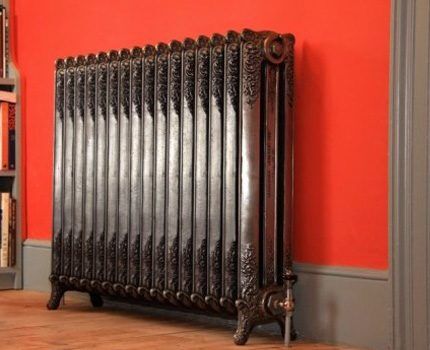
In addition, due to the high temperature of the water in old-style batteries, the intersection gaskets gradually wear out and a leak may occur.
Problems associated with long-term operation of cast iron radiators can be quickly eliminated in the summer. The internal cavities of the sections are easily cleaned of deposits with a special tool.
Due to the resistance of cast iron to mechanical processing, the quality of the radiators does not suffer. When reassembling the sections, you can immediately replace worn gaskets.
The increased inertia of heat transfer from cast iron radiators is ensured by the weight of the structure and the large internal volume of coolant.
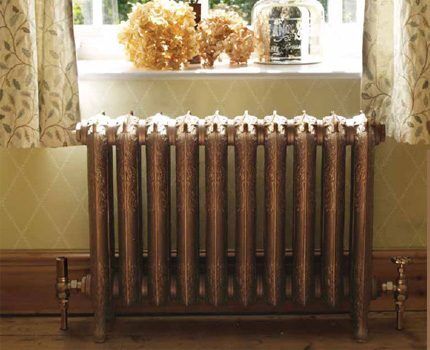
As for the cost of one cast iron section, it is within the same range as the price of its aluminum or steel counterparts. Therefore, the cost of purchasing batteries made of cast iron will not be more than radiators made of other materials.
However, cast iron products are much better tolerated water hammer, firmly resist short-term pressure increases up to 16 bar.
The ability to operate at high temperatures and high pressures is ensured by the small coefficient of thermal expansion of cast iron. Among all the materials from which heating batteries are made, it has the smallest.
Because of this, cast iron is most resistant to microcracks during long-term use. The same property ensures stable tightness of threaded connections and gaskets at a pressure of 8-9 atmospheres.
And such an advantage as high heat transfer due to radiation allows cast iron radiators to be placed near the wall. To maximize the direction of thermal radiation deep into the room, it is recommended to mount special reflectors on the wall behind the battery.

In addition, cast iron radiators are convenient and easy to install. Sections of cast iron batteries are connected to pipes and to each other using threaded connections and paronite gaskets. A special key allows you to separate any sections without removing the outer radiators.
And the long service life once again confirms the quality and reliability of this heating equipment - cast iron radiators are guaranteed to last 50 years.
But they will last this long only with regular maintenance, which consists of periodically removing internal deposits and replacing gaskets.
The listed advantages of cast iron batteries make them indispensable in large rooms with an extensive heating network and high operating pressure.
Disadvantages of cast iron batteries
Despite many advantages, cast iron radiators have a number of disadvantages. This was facilitated by both the design features and the properties of the cast iron itself. For example, cast iron batteries have difficulty integrating into automatic temperature control systems.
Due to the inertia of heat transfer, it is quite difficult to control the set temperature in the room. After all, after turning off the boiler, cast iron radiators will give off their heat for another hour, warming the surrounding air.
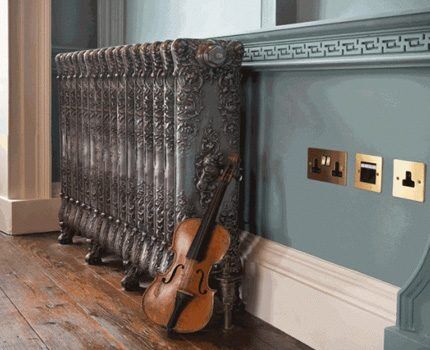
There are also other disadvantages, including:
- large volume of coolant;
- significant weight of one radiator;
- design uniformity.
The large volume of water in the battery also has its disadvantages. Warming up the entire coolant requires more time and energy resources.
In addition, the load on the pump increases, which is forced to pump a significant amount of water in one heating cycle.
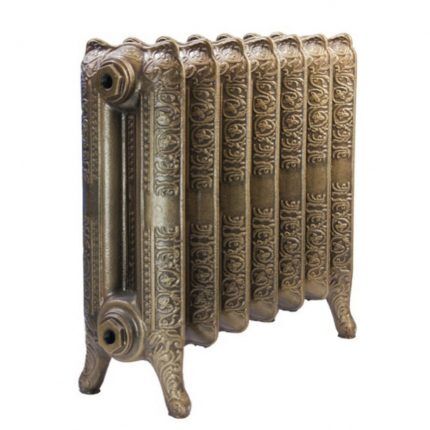
The heavy weight of the devices is also a disadvantage that worries installers and service departments more than residents.However, when assembling a heating system yourself, you cannot do without an assistant when attaching the cast iron battery. The weight of one section is about 7 kg.
Such a disadvantage as design uniformity is due to the technological features of cast iron - they do not allow creating elegant parts from this material. The batteries look the same.
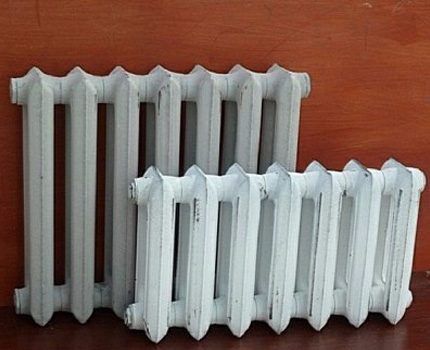
To diversify the model range, manufacturing companies produce cast iron radiators with a beautiful pattern on the surface, but their cost is 10-20 times higher than the price of simple models.
However, if you do not have the funds for expensive exclusive models, you can purchase ordinary radiators and then disguise them using battery screen.
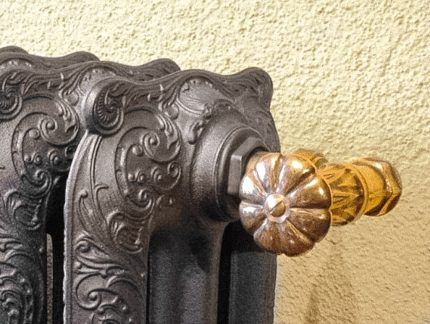
Another drawback is the equipment’s vulnerability to water hammer. The fact is that cast iron is a strong, but rather fragile material. According to GOST 8690-94, radiators must withstand short-term pressure of 1.5 MPa.
But sometimes the pressure can exceed this value. This happens when the pump starts abruptly and there are no compensators. As a result, cast iron batteries may crack or burst.
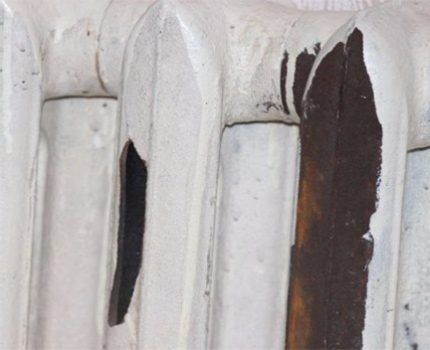
In many cases, the advantages of cast iron radiators greatly outweigh their disadvantages.It is this fact that helps such batteries maintain a good position in the heating systems market.
Technical characteristics of radiators
Competition in the radiator market is extremely high, so there are not many manufacturers producing and selling cast iron batteries on the domestic market.
Before purchasing, you should familiarize yourself with the technical characteristics of the most common cast iron heating radiators. This will allow you to choose exactly the products that are most suitable for the planned or existing heating system.
Manufacturers of cast iron batteries
A market feature of cast iron batteries is the large share of transportation costs in their final cost. Therefore, models from manufacturers from far abroad are not represented on the domestic market.
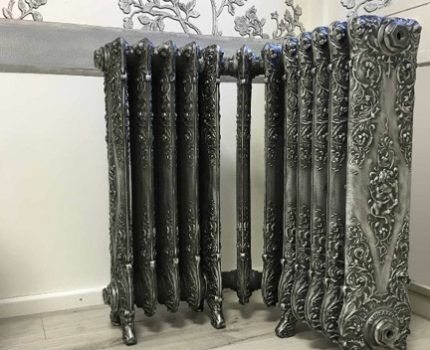
The main factories that offer cast iron batteries are:
- Adarad (Türkiye);
- Cheboksary Aggregate Plant (Russia);
- Viadrus (Czech Republic);
- Demrad (Türkiye);
- Minsk Heating Equipment Plant (Belarus);
- KIRAN (Ukraine);
- Konner (China).
There are many European manufacturers of cast iron radiators, but their products are not competitive. It has a high price, and the quality is comparable to domestic samples.
Devices for organizing heating in a vintage style are offered by a St. Petersburg manufacturer:
Overall dimensions of radiators
The sizes of radiators in the post-Soviet space were standardized. The distance between the center of the axes of the supply and discharge coolant pipes was 300 or 500 mm.
The depth of the sections and their width were not regulated and differed from one manufacturer to another.Most modern radiators are also adapted to these standards.
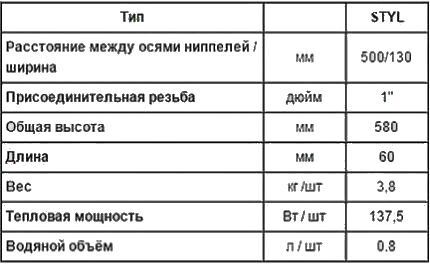
The most common model of cast iron batteries is MS-140. This is what stands in most Khrushchev and nine-story buildings built in the 60-80s of the last century.
The dimensions of its section are: center distance – 500 mm, total height – 588 mm, width – 93 mm, depth – 140 mm.
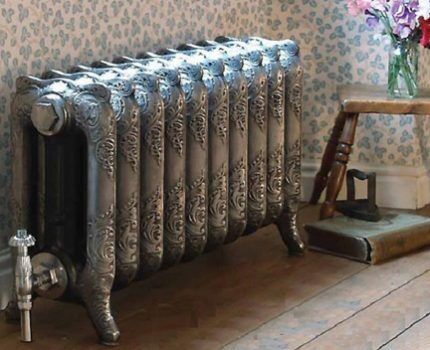
The main goal of creating cast iron radiators with different dimensions is to enable the buyer to choose a model that best fits into the interior. Batteries with a total height of up to 400 mm, for example, fit perfectly into rooms with low window sills.
Appearance and structure of equipment
Almost all cast iron radiators are stacked. They are made of gray cast iron and consist of detachable sections that are connected using nipple bushings. This design allows you to form a solid battery of the required length and power. Paronite gaskets are placed between the sections.
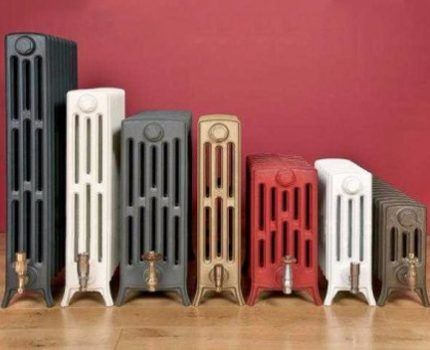
In the horizontal plane between sections, water moves in only one direction. Vertically, the fluid flow occurs through one or more channels. With their number, the area of radiators and their power increases.
The disadvantage of multi-channel sections is their high cost and increased hydrodynamic resistance.
The classic "accordion" look of radiators is becoming a thing of the past. Due to the predominantly radiant method of heat transfer, manufacturers are seeking to increase the area of the battery façade, which results in a flatter appearance. An example is the Konner Modern500 model.
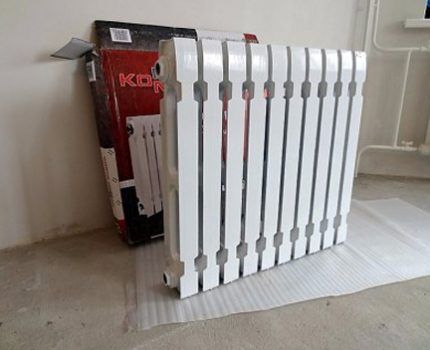
A number of imported models have decorative patterns on the surface, but the cost of such batteries is incomparably high.
The weight of cast iron sections is quite large. The need to maintain wall strength and maximum heating surface area does not allow engineers to greatly reduce the weight/power ratio. The weight of the section of the standard MS-140 model is 7.1 kg.
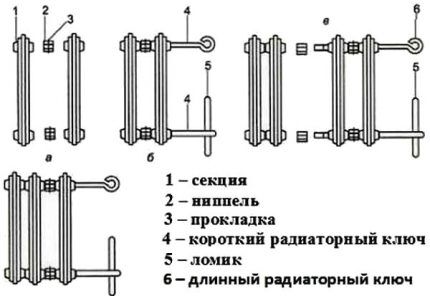
The large mass of cast iron radiators also requires good fastenings. Batteries usually do not have special design elements for fixing to the wall. They are simply hung on special brackets, which are pushed into the spaces between the sections. There are also special feet for installing batteries on the floor.
Thermal power of devices
The power of radiator equipment is characterized by the ability to release thermal energy at the maximum operating temperature of the coolant. This indicator in cast iron radiators depends mainly on their surface area.
Depending on the model, the power can range from 80 to 200 W per section. These are passport values, which in real conditions can be much lower.
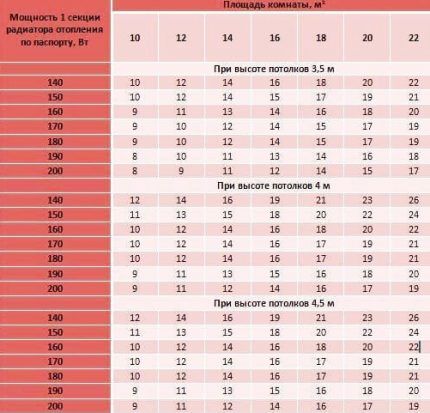
There is a classic formula for calculating the required power of a cast iron heating battery, based on the volume of the room: for every 25-30 m3 Radiators with a total capacity of 1 kW must be installed. If there are 2-3 external walls, this indicator should be adjusted towards increasing power. For more information on how to calculate the required number of batteries for heating, read this material.
To enhance heat transfer due to convection, some models of cast iron radiators are equipped with ribs between the columns. This design can increase the power of the section by 20-40%. You should remember the need to regularly clean such jumpers from dust.
Other equipment characteristics
When choosing radiators, you should pay attention to their other characteristics:
- maximum working pressure;
- coolant volume in the section;
- maximum coolant temperature.
All of the above indicators for cast iron batteries are higher than for aluminum and bimetallic analogues. But the characteristics may differ for different models, which should be taken into account when selecting the components of a new heating system.
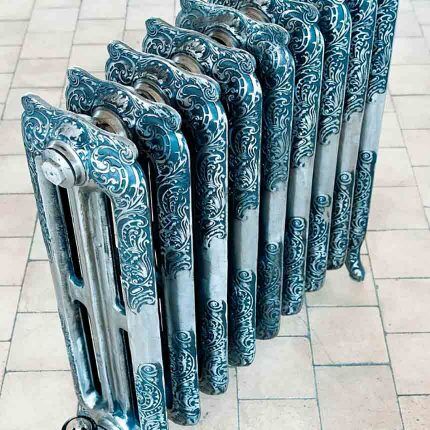
Maximum settings are especially important when replacing batteries connected to a central heating system. When it is pressurized in the fall, excess pressure is supplied to the pipes, which can rupture unsuitable radiators.
This can result in flooding of both your own and the apartment located below, so special attention must be paid to the operating values of pressure and temperature of the coolant.
Conclusions and useful video on the topic
The presented video materials on cast iron radiators will help when choosing a specific model and will further explain their technical characteristics.
Cast iron radiator review:
Comparison of thermal characteristics of radiators made of different materials:
Choice heating radiators, including cast iron, must be produced taking into account their technical characteristics. This will avoid rupture of the heating circuit at maximum loads and provide sufficient heat to the heated rooms.
Please write comments, share your experience of using cast iron radiators, and ask questions in the block below. We are always ready to clarify unclear points.




We also have cast iron radiators in our house. My wife has been dreaming of this for a long time and asks me to replace them with registers or bimetallic convectors. After all, cast iron batteries are very difficult to clean from dust and repaint.The house is large, there are up to a dozen heating appliances, and it takes a lot of time to clean everything. But it turns out that they have a lot of advantages and a very long service life. So now I won’t agree to any persuasion; my wife will have to put up with such radiators for a long time. At the same time, we will save on unnecessary reconstruction of the heating system.
And I’m just one of those wives who don’t like to wash cast iron radiators. It is unrealistic to wash all the dust inside, and it also takes a lot of time. I also dreamed of replacing these batteries with something else. True, the husband did not want to and gave reasons “for”, such as those described above. And recently I bought two brushes, specifically for painting the inside of such radiators. The brush has a long handle and is curved at the end at an angle (approximately 130*) with long bristles. Such a simple device at first glance, but it is very convenient to wash and paint these cast iron monsters in hard-to-reach places. Buy the same ones and it will be much easier for your wife to take care of the radiators.
Hello. Any wife doesn’t like to wash radiators :) I’ll share my experience. I attach a damp rag to the back of the radiator. I blow out the batteries with a hairdryer and all the accumulated dust settles on the rag. I remove the rag and also use a brush to go over the inside of my knees. Melamine sponges work great on the outside.
I wouldn't say that cast iron is all that similar. It’s just that our market is flooded with aluminum radiators, which, by the way, are no less of the same type, and cast iron is a thing of the past. Many people want to buy a beautiful cast iron battery with designs and engravings, but when they compare the price with regular aluminum, they immediately change their mind. I'm the same way myself. Nowadays cast iron is the lot of rich guys.As for its technical qualities, it certainly holds heat better, but in the current realities, this is completely unnecessary. Aluminum does its job just as well as cast iron, plus it doesn’t need to be painted and cleaned year after year.
The article does not indicate another Russian manufacturer of cast iron batteries! Nizhny Tagil Iron Foundry! In terms of price=quality ratio, the best representatives on the market! Cast iron radiators are made to order, both standard hanging and with legs. Mostly white and black! Black batteries are certainly cool!)
It’s just a shame that they didn’t mention another manufacturer of cast iron radiators in Russia.
Nizhny Tagil Boiler and Radiator Plant. They also make regular Soviet radiators with patterns. Compared to Turkey and China, they hold more pressure, and their price is not like a foreign car.